The Importance of Sanding Before Painting Furniture
When it comes to painting, sanding before painting furniture is one of the most important steps. It’s what prepares the surface of the wood for paint, and if you skip this step, your paint is likely to scratch or peel easily down the road.
Painting furniture is a great way to give it a new look without spending a lot of money. But in order to get a professional-looking finish, sanding furniture first is crucial!
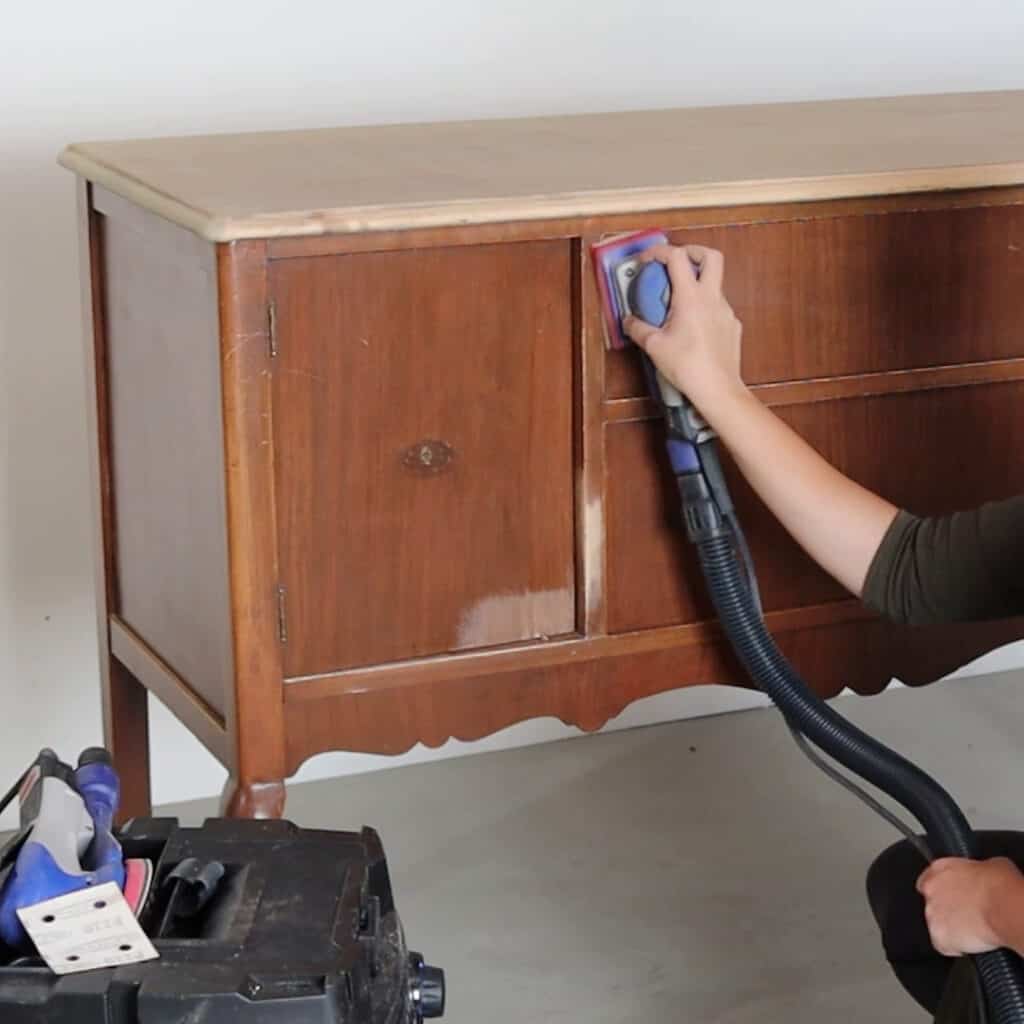
Sanding helps to rough up the surface of the wood so that the paint will have something to cling to.
It also helps to smooth out any imperfections or scratches in the wood, resulting in a better looking paint job.
And in some cases, sanding gives you a chance to remove any old paint or varnish that may be peeling off the furniture.
Sanding Before Painting Furniture
I know, I want to get painting too. But, sanding before painting furniture is honestly really important if you want your paint to look good and to last a long time without scratching or peeling off.
Even if you’re using paint that has great adhesion, like chalk paint, we really need to take a few minutes and sand first.
Should I Sand Furniture Before Painting?
Absolutely! Sanding plays a major role in creating a long lasting, durable painted finish on your furniture. This is especially true with any furniture that is not raw wood.
With raw wood furniture though, sanding is still important to smooth out the wood before painting.
Don’t worry, sanding before painting doesn’t need to be a big job! Just take a few minutes to lightly scuff up the surface with some sandpaper. Learn all about sanding for paint prep here!
Why Should I Sand Furniture Before Painting?
Sanding will make it easier for the paint to hold onto the surface of the furniture. Think about how hard it is for you to hold onto something that is slick, like ice. It easily falls out of your hands, right?
But when you have a towel in your hand, you can hold onto the ice a lot easier. It’s the same type of thing with sanding before painting.
Lightly sanding glossy or slick surfaces is like putting a towel in your hands so you can hold onto the ice.
Sanding creates a surface that the paint can stick to easier. And it makes it harder for the paint to scratch or chip off in the future.
What happens if you don’t sand before painting furniture?
If you don’t want to sand, you can still make paint stick to your furniture, but it won’t stick as well, and honestly, it just won’t be as good of a paint job.

As an Amazon Associate, I earn from qualifying purchases. I also may earn from other qualifying purchases with other companies or get free product to review and use. All opinions are my own.
You can use a really good bonding primer like BIN shellac based primer instead of sanding.
BIN primer will also block bleedthrough stains from coming through your paint, and it helps your paint have better coverage. Read through this post for the best primers for painting furniture.
But even with the primer, you’ll get better results in the long run if you sand before priming.
If you’re just looking for a quick update, and you don’t care if it looks good for more than a couple of days, then go ahead and skip the sanding.
Just know that it will most likely get scratched anytime anything touches it.
(If you really don’t want to sand or prime before painting furniture, here is probably the easiest and best way for painting furniture without sanding or priming. Also, check out this post to learn more about the best paints for furniture without sanding.)
How to Sand Furniture Before Painting
Now that you know sanding before painting is important, let’s talk about how to sand furniture. You’ll want to use a fine-grit sandpaper like 150-grit or 220-grit.
If you’re sanding a large piece of furniture with a lot of flat surfaces, you can use an electric sander with 220 grit sandpaper.
But sanding by hand is perfectly fine. Here are the best hand sanders for furniture.
My preference is to use 220 grit sandpaper and sand in the direction of the grain. Check out my guide on how to sand wood by hand here.
You don’t need to sand too hard, just enough to scuff up the surface and dull the shine.
Sandpaper for Painting Furniture
There are a lot of different sandpapers available on the market these days.
You can use anything from foam sanding sponges, to regular paper sandpaper… and even sanding screens that are very effective at sanding off an old finish.
And then there are grits, all named with numbers… For most furniture painting projects, I like to use 220 grit sandpaper. It’s a nice middle ground that isn’t too rough or too soft.
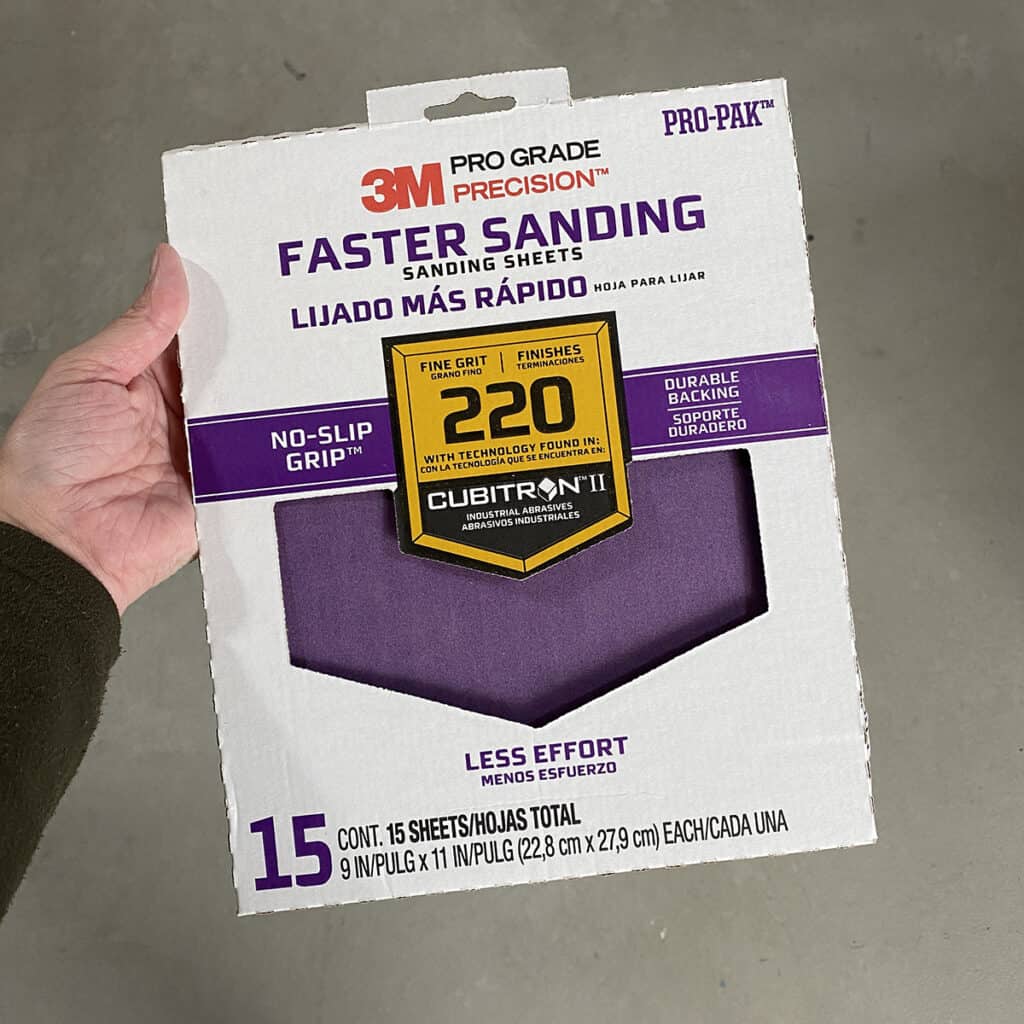
This 3M Pro sandpaper is my favorite brand. It’s a little more expensive than others, but it lasts so much longer.
The cheaper kind of sandpaper rips easily, and the grittiness of it doesn’t last as long as my favorite sandpaper.
On furniture that has a lot of curves, details, and trim, these 1/2″ squishy foam sanding sponges (use code RAY10 to get 10% off your SurfPrep order) are really nice.
You can buy some that fit onto your electric sander. Check out our blog post about how to sand curved surfaces and learn to tackle any curved surface on your furniture.
Or for sanding curves and details by hand, I like the 1/2″ squishy foam pads without vacuum holes (use code RAY10 to get 10% off your SurfPrep order).
Check out this post to get more information on SurfPrep sanding sponges. Learn more about sandpaper for furniture painting here.
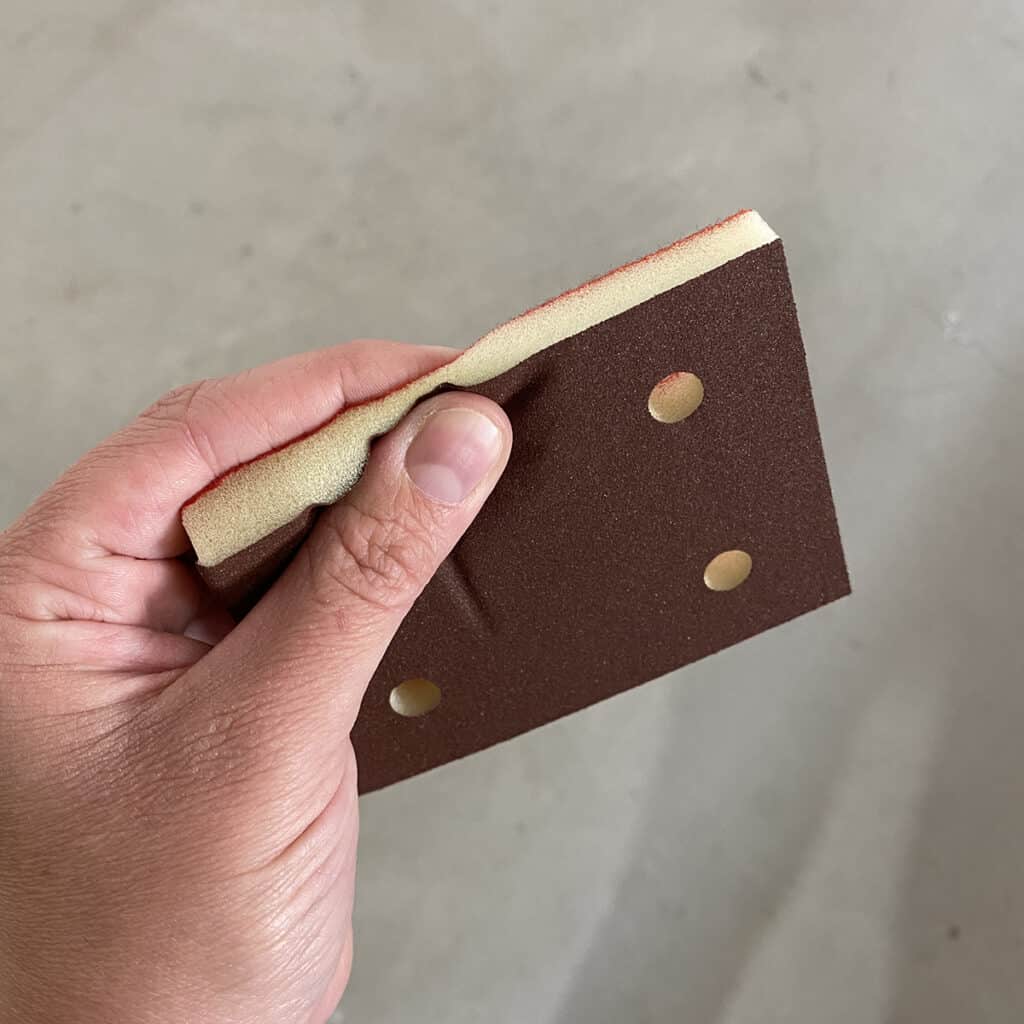
By the way, I sand a lot, so I bought myself a 3×4″ SurfPrep electric sander. It has been a lifesaver! Check out this post to learn if the SurfPrep sander is right for you!
(If you love the idea of the SurfPrep sander but you need a cheaper option, here’s a great SurfPrep sander alternative that will help reduce dust while sanding and help you get into corners AND you can use squishy foam pads too!)
What grit sandpaper should I use before painting furniture?
For most furniture painting projects, I recommend using 220 grit sandpaper. It’s a nice middle ground. 220 grit also doesn’t leave deep scratches, so it literally just scuffs the surface a bit.
You can use 150 grit too… I personally feel like it scratches too much though.
How much should you sand before painting?
You don’t need to sand too hard, just enough to scuff up the surface so the paint will adhere better.
If you’re sanding by hand, it shouldn’t take more than probably 15 minutes to lightly scuff sand a large dresser.
If you’re using an electric sander, it’ll go faster. But with an electric sander, like an orbital sander, you’ll need to pay close attention not to sand for too long or push too hard in any one spot.
A good rule of thumb is to sand until the finish doesn’t have any sheen anymore. It should feel a little scuffed, and not as slick as before.
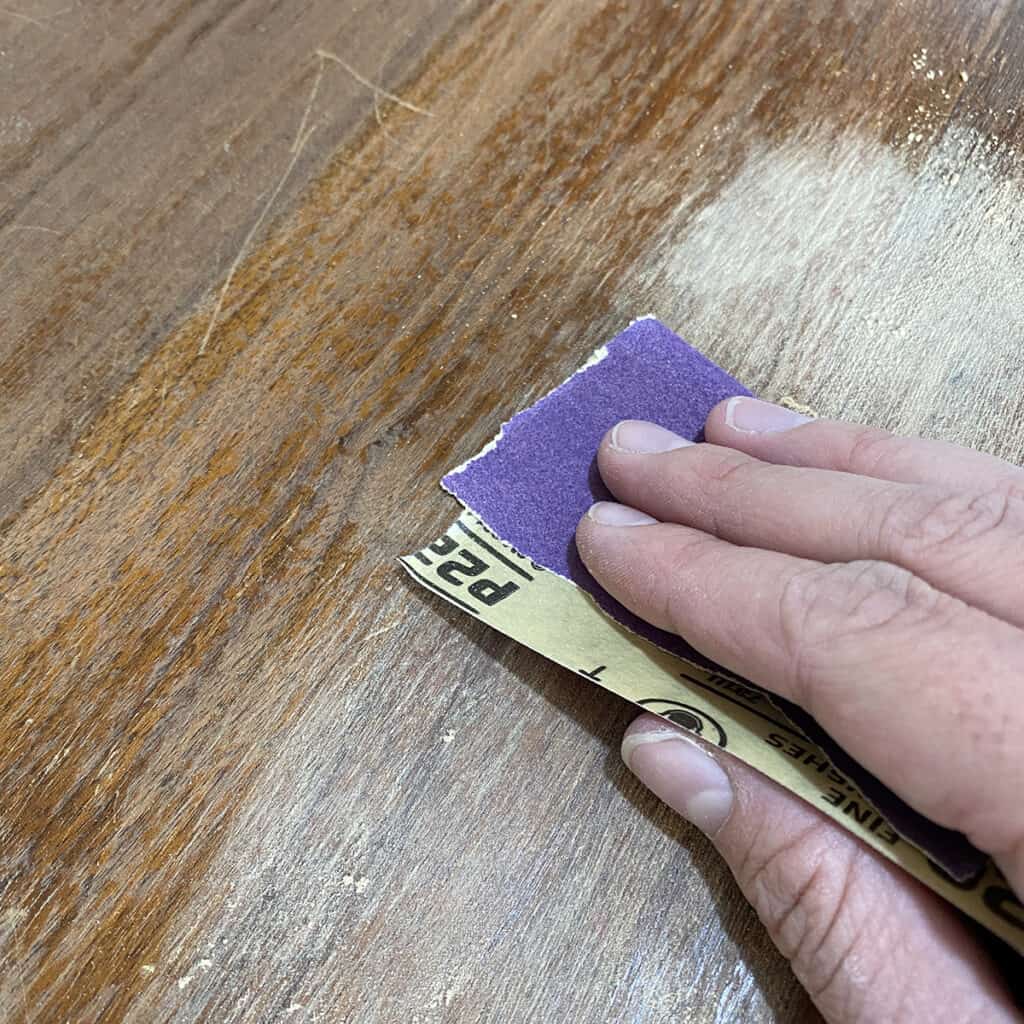
Literally… a few passes back and forth, all over the surface. And then you’re done.
Do I have to sand laminate before painting?
Sanding before painting is still important ESPECIALLY if you’re painting laminate furniture. Laminate has a shiny surface that needs to be sanded before painting so the paint will adhere properly.
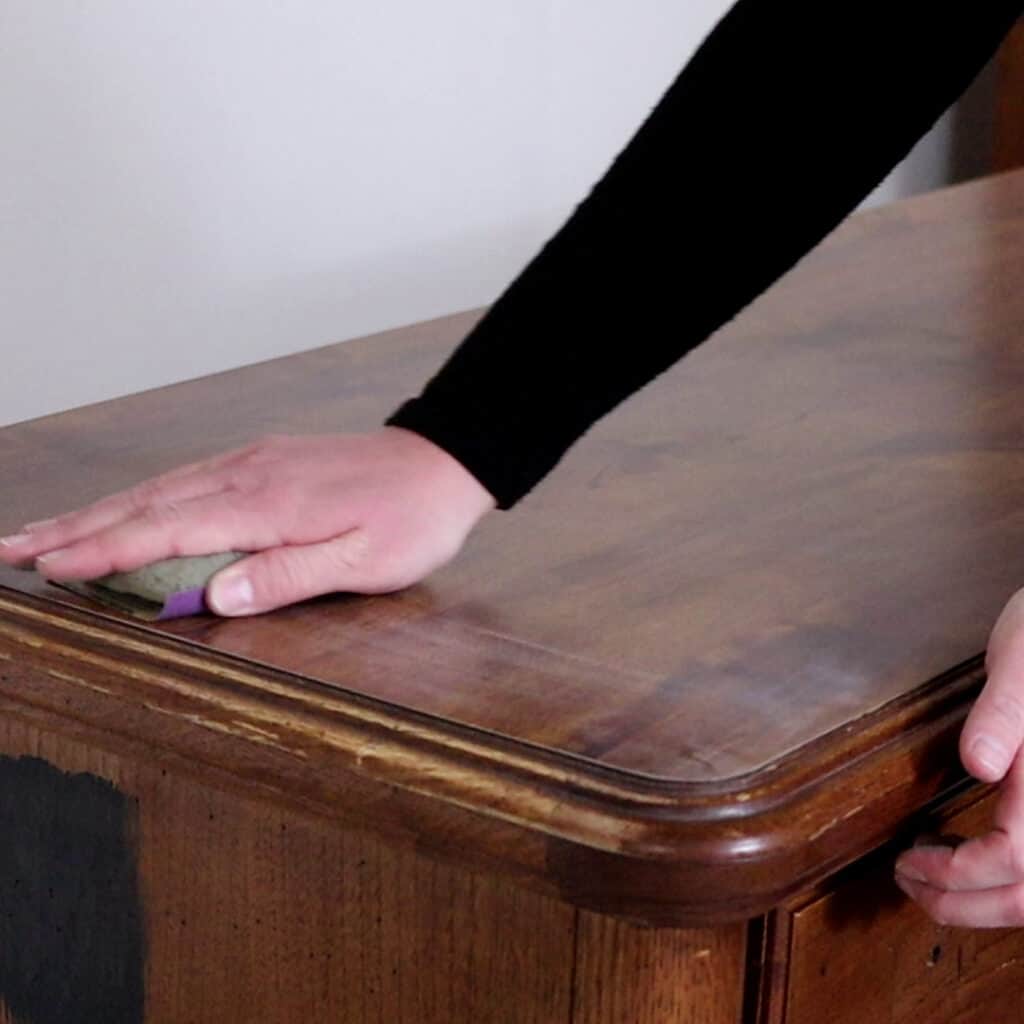
It’s more slick than wood furniture is, so it needs to be scuff sanded a little more than wood furniture does before painting.
Just sand the laminate until the shiny-ness is gone. There is no need to go through the laminate. You just want to scuff up the laminate.
Here’s a great example of how to paint laminate furniture without sanding vs sanding.
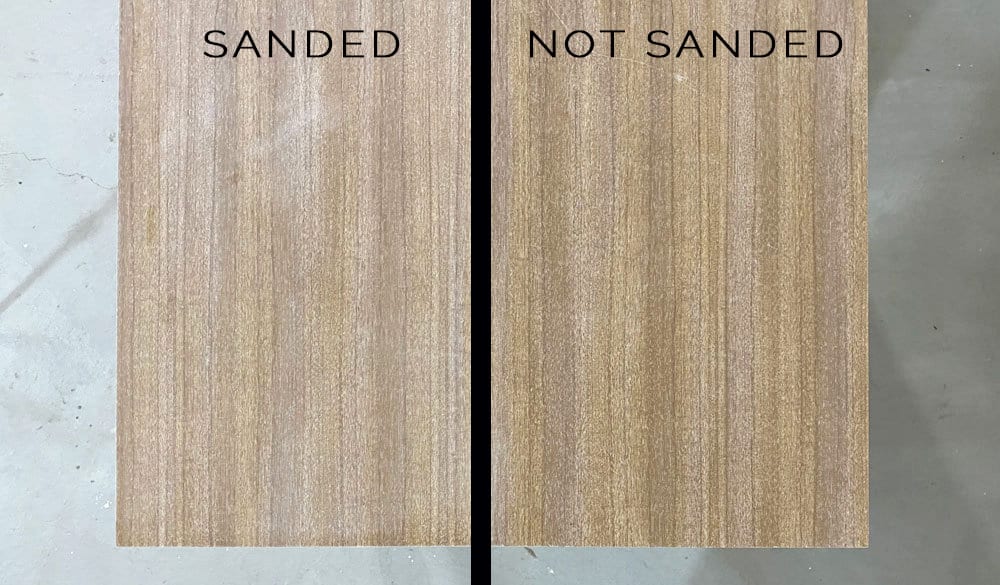
Can I paint over varnished wood without sanding?
Varnished wood is the most important type of wood to sand before painting.
The varnish makes the surface slick and shiny, and paint won’t be able to stick to it very well if you don’t scuff up the surface first.
This type of wood is what we mostly work with when we paint furniture. It’s been stained and topcoated, but now it’s old and worn out, so we paint it to make it pretty again.
You’ll definitely want to scuff sand your previously finished furniture before you paint, so your paint job lasts as long as possible.

Is it better to sand or strip furniture?
It depends! I only strip furniture before I paint if the paint on the furniture was poorly done.
So if there is paint on the furniture and it scratches off with my fingernail, or if it’s peeling off… Then I strip off the paint with a chemical stripper to remove all of the paint.
Here’s a great tutorial on how to remove paint from furniture. Stripping furniture is messier than sanding. It’s also more toxic and it takes a lot of time.
But, sanding through a few layers of paint also takes a lot of time. And breathing in paint dust isn’t healthy either.
And in cases where you want to sand or strip wood furniture legs, you might pick one or the other based on how much detail (ex. grooves and crevices) there is.
Most of the time though, you don’t have to remove paint from your furniture before you paint it. If you don’t need to remove the paint, then there is no need to strip.
But for best results, you’ll still need to lightly sand before painting.
So, should you be sanding before painting furniture? The answer is yes – it’s always a good idea to give your piece a light sanding before priming and painting.
Do I need to sand between coats of paint on furniture?
Yes, it’s a good idea to sand between coats of paint on furniture. This helps to smooth out any imperfections or brush strokes from the previous coat of paint.
It also helps the next coat of paint to adhere better and have a smoother finish. A light sanding with fine grit sandpaper (220 or higher) will do the trick.
You don’t have to sand between coats of paint, but it will help improve the overall finish.
Especially if you notice any rough patches or brush strokes, sanding helps to even out the surface for a more flawless final result.
Are there any tips for minimizing dust while sanding?
One way to minimize dust while sanding is to use a vacuum or shop vac to suck up the dust as you sand. This will help keep your work area cleaner and reduce the amount of dust that gets into the air.
You can also attach a hose from your vacuum directly to your sander for even more effective dust collection.
Another tip is to wear a dust mask or respirator while sanding. This will help prevent you from inhaling any harmful particles that may be present in the dust.
It’s also a good idea to work in a well-ventilated area, either outdoors or with open windows and fans running. This will help to disperse the dust and prevent buildup in one area.
More Furniture Sanding Resources
- Sanding Furniture – 15 Tips & Pro Secrets
- Best Sanders for Furniture
- Best Sanders to Remove Paint
- SurfPrep vs Festool Sander Reviews
- Honest SurfPrep 5″ Orbital Sander Review
Follow us on YouTube to get more tips for painting furniture.
Or share your project with us on our Facebook Group and be part of our community. See you there!



